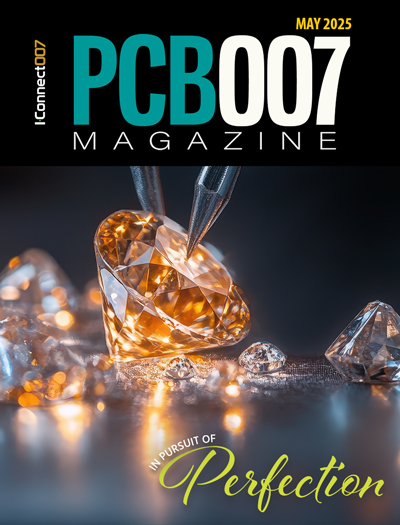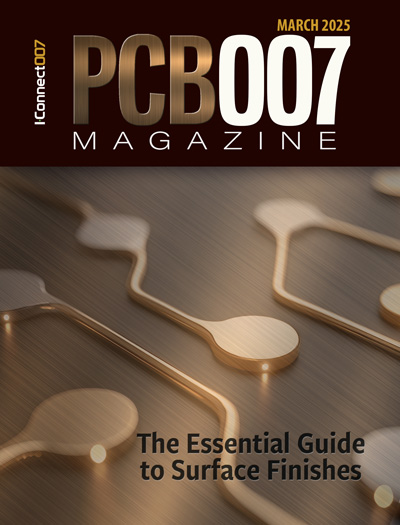-

- News
- Books
Featured Books
- pcb007 Magazine
Latest Issues
Current Issue
In Pursuit of Perfection: Defect Reduction
For bare PCB board fabrication, defect reduction is a critical aspect of a company's bottom line profitability. In this issue, we examine how imaging, etching, and plating processes can provide information and insight into reducing defects and increasing yields.

Voices of the Industry
We take the pulse of the PCB industry by sharing insights from leading fabricators and suppliers in this month's issue. We've gathered their thoughts on the new U.S. administration, spending, the war in Ukraine, and their most pressing needs. It’s an eye-opening and enlightening look behind the curtain.

The Essential Guide to Surface Finishes
We go back to basics this month with a recount of a little history, and look forward to addressing the many challenges that high density, high frequency, adhesion, SI, and corrosion concerns for harsh environments bring to the fore. We compare and contrast surface finishes by type and application, take a hard look at the many iterations of gold plating, and address palladium as a surface finish.
- Articles
- Columns
Search Console
- Links
- Media kit
||| MENU - pcb007 Magazine
EIPC Reliability Workshop, Tamworth, UK, September 22, 2016
October 3, 2016 | Pete Starkey, I-Connect007Estimated reading time: 17 minutes
Lewis concluded by reporting that since implementing IST, Airbus Defence and Space had experienced no test failures at assembly or equipment level that could be linked to the base PCB. IST had also enabled the direct comparison of dissimilar constructions for new product introduction and had been utilised as a risk reduction tool for current and future product.
The morning’s workshop programme provoked lively discussion and debate which continued through the lunch break, and the afternoon session commenced with Emma Hudson from Underwriters Laboratories expanding upon the partnership that UL had established with PWB Interconnect Solutions, referred to in Bill Birch’s presentation, to develop the UL IST Baseline Performance Programme. The objectives were vendor pre-qualification, technology and material characterisation, lot conformance, process and plating monitoring and trouble-shooting. The test programme included test vehicle design, reliability testing by IST, material robustness by DELAM, failure analysis, material analysis and database reference, with performance criteria driven by customers.
With the increasing demand for demonstrated reliability from all industry segments, IST was becoming an industry standard method for measuring PCB performance. But global industry performance standards were needed with representative test criteria based on specific industry product life cycles for consumer, computer, telecom, medical, automotive and aerospace sectors. And it was necessary for PCB performance standards to include standardised test vehicle design, a standardised test method, pre-conditioning based on the stresses experienced during the assembly process, and performance levels that correlated between quality and reliability specifications.
Based on data gathered by PWBIS over many years, a series of standardised test vehicles had been designed: cross-functional with 12- and 24-layer PTH coupons; automotive with 8-layer buried and microvia coupons; and 20-layer lead-free material reliability coupons for HDPUG. Under development was a standardized 4-, 6- and 8-layer flex test vehicle with sequential lamination coupons, for medical diagnostic equipment and implantable devices. Hudson discussed test coupon panel layouts, stressing that these were only relevant for the Baseline Performance Programme—standard IST testing would still require coupons to be included on the production panel. Test procedures were in accordance with IPC-TM-650 method 2.6.26.
She described the procedure for the IST Baseline Performance Programme: the client chose the technical level and the preconditioning temperature, and submitting between 16 and 30 coupons of each technical level to UL for testing, UL tested eight coupons per technical level and entering the results in the UL-IQ database. This entry effectively gave the client a “brand reference” supported by a Guide Card explaining the parameters and the test method used, which could give OEMs and ODMs an indication of the client’s capability. No follow-up services were proposed—this was presently seen to be a one-off exercise, but OEM feedback was being sought. As a point of clarification, she emphasised that there was no relationship between safety certification conducted by UL and any performance testing carried out—these were different tests looking at different aspects of the PCB and a failure in a performance test would have no bearing on a client’s UL safety certification.
Having made the clear distinction between reliability and safety, Emma Hudson then focused on UL safety standards and concluded the workshop programme with an extremely informative review of the consequences of the update of FR-4 classification for UL Recognised PCBs. As FR-4 had continued to evolve to meet industry and environmental needs, and halogen-free materials had been introduced, it had been necessary to split FR-4 laminates into two distinct groups because halogen-free FR-4 materials did not behave in the same way as traditional brominated FR-4 materials. So, as of June 2014, “FR-4” no longer officially existed as a UL/ANSI grade for laminates, and materials had been re-classified as either “FR-4.0” for brominated materials or “FR-4.1” for halogen-free. A small number of modified FR-4.0 and FR-4.1 materials did not fit with either classification and had to be treated as non-ANSI grades.
Hudson deftly guided her audience step-by-step through the hierarchy of procedures involved in creating a new UL Recognised PCB, updating an existing UL Recognised PCB, and adding a new FR-4.1 material to an existing UL Recognised PCB. She also clarified the route for adding a new solder resist to an existing UL Recognised PCB and decreasing the minimum build-up thickness of existing UL Recognised PCB, with examples of typical combinations and definitions and details of when and what additional testing might be required. In essence, the UL 796 PCB test requirements were the same for FR-4.0 and FR-4.1 as any other UL/ANSI grade, and additional FR-4.1 testing might be needed to make changes to existing “FR-4” board types based on historically conducted testing. Additional testing could be expected when adding solder resists to FR-4.1, as most were officially recognised for use in combination with FR-4.0 only, and when a resist was not officially recognised in combination with a UL/ANSI grade, additional 1.6 mm flame testing was necessary. Her efforts in helping to clarify a potentially formidable set of procedures were greatly appreciated by workshop delegates.
A full and highly enlightening day of presentations and discussions was rounded off with a tour of Amphenol Invotec’s factory in nearby Dosthill, an excellent example of a facility dedicated to technologically complex, small-batch, high-mix manufacture of high-reliability HDI and flex-rigid multilayer PCBs for defence and aerospace applications.
Page 3 of 3Suggested Items
BEST Inc. Introduces StikNPeel Rework Stencil for Fast, Simple and Reliable Solder Paste Printing
06/02/2025 | BEST Inc.BEST Inc., a leader in electronic component rework services, training, and products is pleased to introduce StikNPeel™ rework stencils. This innovative product is designed for printing solder paste for placement of gull wing devices such as quad flat packs (QFPs) or bottom terminated components.
See TopLine’s Next Gen Braided Solder Column Technology at SPACE TECH EXPO 2025
05/28/2025 | TopLineAerospace and Defense applications in demanding environments have a solution now in TopLine’s Braided Solder Columns, which can withstand the rigors of deep space cold and cryogenic environments.
INEMI Interim Report: Interconnection Modeling and Simulation Results for Low-Temp Materials in First-Level Interconnect
05/30/2025 | iNEMIOne of the greatest challenges of integrating different types of silicon, memory, and other extended processing units (XPUs) in a single package is in attaching these various types of chips in a reliable way.
E-tronix Announces Upcoming Webinar with ELMOTEC: Optimizing Soldering Quality and Efficiency with Robotic Automation
05/30/2025 | E-tronixE-tronix, a Stromberg Company, is excited to host an informative webinar presented by Raphael Luchs, CEO of ELMOTEC, titled "Optimize Soldering Quality and Efficiency with Robotic Automation," taking place on Wednesday, June 4, 2025 at 12:00 PM CDT.
CE3S Launches EcoClaim Solutions to Simplify Recycling and Promote Sustainable Manufacturing
05/29/2025 | CE3SCumberland Electronics Strategic Supply Solutions (CE3S), your strategic sourcing, professional solutions and distribution partner, is proud to announce the official launch of EcoClaim™ Solutions, a comprehensive recycling program designed to make responsible disposal of materials easier, more efficient, and more accessible for manufacturers.


